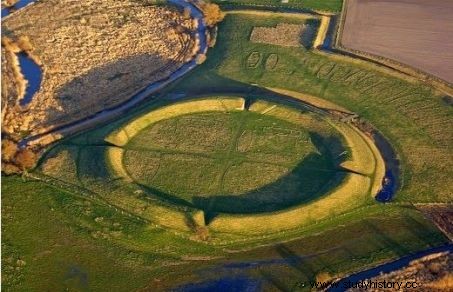A Viking enclosure dating from the reign of Harald the Blue Tooth has been discovered south of Copenhagen.

Inset, the Viking fortress of Borgring, Denmark. 3D rendering from LIDAR data.
A perfect circle! One ring to rule them all … Aerial surveys carried out using LIDAR (airborne laser scanning) have uncovered the presence of a circular Viking fortress at Borgring, south of Copenhagen, the Danish capital. Fitted out on the X th century, it would be the first monument of this type encountered in Denmark for 60 years. In a recent article published in the journal Antiquity , the authors argue that Borgring belonged to an enigmatic network of fortifications called Trelleborg, named after the original model discovered near Slagelse, Zeeland.

Aerial view of Trelleborg Fortress, Zeeland, the eponymous site of the Viking ring fortifications.
These are imposing ring-shaped fortresses with military and defense purposes. Consisting of an embankment of wooden and earthen ramparts lined with a V-shaped ditch, the fortress of Borgring, with a diameter of 150m, had four gates located at the four cardinal points.

3D reconstruction of the Viking fortress of Borgring. © Peter Jensen Archaeological IT, Aarhus University.
In Denmark, only 5 constructions of this kind, perfectly round, are currently known (Fyrkat, near Hobro, Aggersborg, Nonnebakken and of course Trelleborg). According to Soren Sindbaek, an archaeologist at the University of Aarhus, these fortifications would have been erected in a very short period of time, between 975 and 980, under the rule of King Harald the Blue Tooth* (Haraldr Gormsson ) (910-986), the sovereign to whom we owe the unification of Denmark and its Christianization. Why are these elevations intriguing? This is because the Vikings have always been seen as small societies of wrens competing for power. And these works built on a strictly identical plan, requiring major earthworks, rather suggest a concentration of labor, united in a common effort, under the direction of a planning authority. All were built in a similar environment:in the center of fairly populated fertile regions; near major thoroughfares; with longhouses inside; at the outlets of rivers having access to open water; and in highly visible places, invulnerable to attack from the sea. These fortresses bear witness to a degree of organization and centralization hitherto unknown in Viking culture. No doubt linked to an exceptional military situation. When the Vikings had to face powerful external enemies, Slavs and Germans.

At the annual Trelleborg Festival, Viking battles are re-enacted. © Nissen Mads /AP/SIPA
*Harald the blue tooth, says "Bluetooth in English, never imagined that 1000 years after his death, his name would be given to a wireless computer connection!
